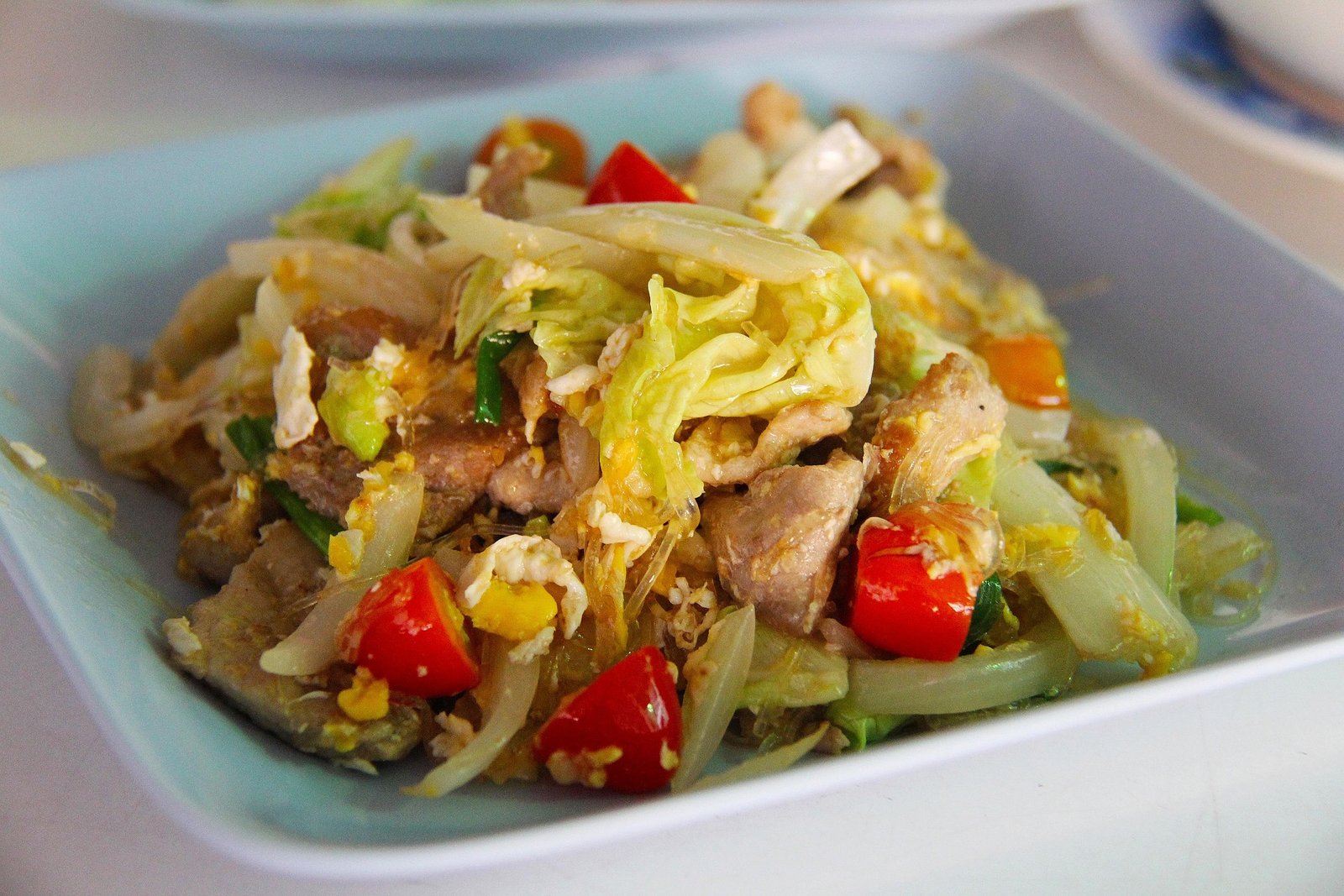If you’re heading to Thailand or just craving a taste of its vibrant cuisine, you’re in for a treat. Thai food is a global favorite, blending spicy, sweet, sour, and salty flavors into dishes that are as bold as they are delicious. Whether you’re a digital nomad on the Destination Thailand Visa (DTV) exploring Bangkok’s street markets or settling into Chiang Mai’s food scene, this guide covers the best Thai foods you must try in 2025. I’ll walk you through top dishes, their ingredients, where to find them, and why they’re so special. Let’s dig in!
Why Thai Food is a Must-Try
Thai cuisine is a sensory explosion, balancing five key flavors: spicy (chili), sweet (palm sugar), sour (lime, tamarind), salty (fish sauce), and bitter (herbs). From street stalls to high-end restaurants, Thailand’s food scene is accessible, affordable, and diverse. In 2025, Thailand’s culinary tourism is booming, with cities like Bangkok and Chiang Mai ranked among the world’s top food destinations. Whether you’re vegetarian, a spice lover, or a dessert fan, there’s something for everyone.
Benefits of Exploring Thai Food
- Affordable: Street food costs 30–100 THB ($1–$3 USD), while restaurant dishes range from 100–300 THB.
- Cultural Immersion: Eating local dishes connects you to Thailand’s traditions and communities.
- Variety: Options for all diets, including vegan and gluten-free.
- Health Benefits: Many dishes use fresh herbs, vegetables, and lean proteins.
Top 10 Thai Foods You Must Try
Here’s a curated list of the best Thai foods you must try, based on popularity, authenticity, and traveler reviews from 2025. Each dish includes its key ingredients, flavor profile, and where to find it.
1. Tom Yum Goong (Spicy Shrimp Soup)
Overview: This iconic soup is Thailand’s culinary ambassador, known for its fiery, sour, and aromatic broth packed with shrimp and herbs.
Key Ingredients:
- Shrimp (goong)
- Lemongrass, galangal, kaffir lime leaves
- Chili peppers, fish sauce, lime juice
- Mushrooms, cilantro
Flavor Profile: Spicy, sour, and fragrant with a savory kick.
Where to Try:
- Bangkok: Pee Aor (Soi Phetchaburi 5) for creamy tom yum.
- Chiang Mai: Huen Phen for northern-style versions.
- Street Stalls: Look for vendors with fresh shrimp and steaming pots.
Cost: 50–150 THB ($1.50–$4) at stalls; 200–400 THB in restaurants.
Why Try It: It’s the perfect balance of Thai flavors, customizable for spice levels, and a must for seafood lovers.
2. Pad Thai (Stir-Fried Noodles)
Overview: Thailand’s most famous dish, pad Thai is a stir-fried noodle dish with a sweet-savory-tangy sauce, loved worldwide.
Key Ingredients:
- Rice noodles
- Tamarind paste, fish sauce, palm sugar
- Shrimp, chicken, or tofu
- Egg, bean sprouts, peanuts, dried chili
Flavor Profile: Sweet, tangy, and savory with a crunchy texture.
Where to Try:
- Bangkok: Thipsamai (313 Maha Chai Rd) for legendary pad Thai wrapped in egg.
- Phuket: Street vendors at Patong Night Market.
- Chiang Mai: Pad Thai Kitchen near Tha Pae Gate.
Cost: 40–100 THB ($1–$3) at stalls; 150–300 THB in restaurants.
Why Try It: It’s a crowd-pleaser, widely available, and vegetarian-friendly with tofu options.
3. Som Tam (Green Papaya Salad)
Overview: This spicy salad from Isaan (northeast Thailand) is a refreshing, fiery dish made with shredded green papaya.
Key Ingredients:
- Green papaya
- Chili peppers, garlic, lime juice, fish sauce
- Tomatoes, green beans, peanuts
- Optional: dried shrimp, crab
Flavor Profile: Spicy, sour, and slightly sweet with a crisp crunch.
Where to Try:
- Bangkok: Somtam Nua (Siam Square) for authentic Isaan flavors.
- Chiang Mai: Som Tam Udon near the Night Bazaar.
- Isaan Region: Local stalls in Udon Thani or Khon Kaen.
Cost: 30–80 THB ($1–$2) at stalls; 100–200 THB in restaurants.
Why Try It: It’s a spicy, healthy staple that showcases Thailand’s love for bold flavors.
4. Green Curry (Gaeng Keow Wan)
Overview: A creamy, spicy curry made with green chilies, coconut milk, and your choice of protein, served with rice.
Key Ingredients:
- Green curry paste (chili, lemongrass, galangal)
- Coconut milk
- Chicken, pork, or tofu
- Thai eggplant, basil, kaffir lime leaves
Flavor Profile: Spicy, creamy, and aromatic with a rich coconut base.
Where to Try:
- Bangkok: Nahm (Michelin-starred, Sathorn) for upscale curry.
- Chiang Mai: Aroon Rai for northern-style green curry.
- Phuket: Raya Restaurant in Phuket Town.
Cost: 60–150 THB ($2–$4) at stalls; 200–500 THB in restaurants.
Why Try It: Its bold, creamy flavors make it a comfort food favorite, with vegan options available.
5. Massaman Curry (Gaeng Massaman)
Overview: A milder, Muslim-influenced curry with Persian and Indian roots, featuring slow-cooked meat and peanuts.
Key Ingredients:
- Beef, chicken, or tofu
- Coconut milk, massaman curry paste
- Potatoes, peanuts, cinnamon, cardamom
- Tamarind paste, palm sugar
Flavor Profile: Mildly spicy, sweet, and savory with warm spices.
Where to Try:
- Bangkok: The Local (Sukhumvit Soi 23) for authentic massaman.
- Southern Thailand: Krua Talay in Krabi for beef massaman.
- Chiang Mai: Huen Phen for northern variations.
Cost: 80–200 THB ($2–$6) at stalls; 250–600 THB in restaurants.
Why Try It: Its rich, complex flavors and tender meat make it perfect for those who prefer less heat.
6. Khao Soi (Northern Thai Curry Noodles)
Overview: A Chiang Mai specialty, khao soi is a creamy coconut curry noodle soup with crispy noodle toppings.
Key Ingredients:
- Egg noodles (soft and crispy)
- Coconut milk, curry paste
- Chicken, beef, or tofu
- Pickled cabbage, shallots, lime
Flavor Profile: Creamy, mildly spicy, and tangy with a crunchy contrast.
Where to Try:
- Chiang Mai: Khao Soi Khun Yai near Warorot Market.
- Bangkok: Baan Yai (Sathorn) for northern-style khao soi.
- Pai: Khao Soi House for cozy vibes.
Cost: 50–100 THB ($1.50–$3) at stalls; 150–300 THB in restaurants.
Why Try It: It’s a northern Thai gem, blending Burmese and Thai flavors, perfect for noodle lovers.
7. Mango Sticky Rice (Khao Niew Mamuang)
Overview: Thailand’s iconic dessert, featuring sweet sticky rice topped with ripe mango and coconut sauce.
Key Ingredients:
- Sticky rice
- Ripe mango
- Coconut milk, palm sugar
- Sesame seeds or mung beans (optional)
Flavor Profile: Sweet, creamy, and slightly nutty.
Where to Try:
- Bangkok: Mae Varee (Sukhumvit Soi 13) for award-winning sticky rice.
- Chiang Mai: Night Bazaar street vendors.
- Phuket: Weekend Market in Phuket Town.
Cost: 50–120 THB ($1.50–$3) at stalls; 150–250 THB in restaurants.
Why Try It: It’s a refreshing, sweet treat, especially in mango season (March–May).
8. Pad Kra Pao (Basil Stir-Fry)
Overview: A spicy stir-fry with holy basil, often served with rice and a fried egg, loved for its quick preparation.
Key Ingredients:
- Minced pork, chicken, or tofu
- Holy basil, chili, garlic
- Fish sauce, oyster sauce
- Jasmine rice, fried egg
Flavor Profile: Spicy, savory, and aromatic with a basil kick.
Where to Try:
- Bangkok: Phed Mark (Soi Sukhumvit 49) for spicy pad kra pao.
- Pattaya: Street stalls near Walking Street.
- Chiang Mai: Local markets like Chang Phueak.
Cost: 40–100 THB ($1–$3) at stalls; 100–200 THB in restaurants.
Why Try It: It’s a quick, flavorful dish that’s a Thai lunch staple.
9. Laab (Spicy Meat Salad)
Overview: A spicy, tangy salad from Isaan, featuring minced meat and fresh herbs, often served with sticky rice.
Key Ingredients:
- Minced pork, chicken, or beef
- Fish sauce, lime juice, chili flakes
- Toasted rice powder, mint, cilantro
- Sticky rice (side)
Flavor Profile: Spicy, tangy, and herbaceous with a nutty crunch.
Where to Try:
- Bangkok: Somtam Nua (Siam Square) for Isaan laab.
- Udon Thani: Local restaurants for authentic versions.
- Chiang Mai: Huen Phen for northern-style laab.
Cost: 50–120 THB ($1.50–$3) at stalls; 150–250 THB in restaurants.
Why Try It: It’s a bold, protein-packed dish with regional variations (e.g., northern vs. Isaan styles).
10. Gai Yang (Grilled Chicken)
Overview: Marinated, grilled chicken served with sticky rice and spicy dipping sauce, a street food favorite.
Key Ingredients:
- Chicken (marinated in garlic, turmeric, lemongrass)
- Fish sauce, coriander root
- Spicy tamarind or chili sauce (nam jim jaew)
- Sticky rice
Flavor Profile: Savory, smoky, and mildly spicy.
Where to Try:
- Bangkok: Jai Fai (Michelin-starred, Maha Chai Rd) for upscale gai yang.
- Chiang Mai: SP Chicken near Wat Chedi Luang.
- Phuket: Night markets in Patong.
Cost: 50–150 THB ($1.50–$4) at stalls; 200–400 THB in restaurants.
Why Try It: It’s a simple, satisfying dish that pairs perfectly with Thailand’s spicy dips.
Comparison of Thai Dishes
| Dish | Flavor Profile | Cost (THB) | Best Locations | Best For |
|---|---|---|---|---|
| Tom Yum Goong | Spicy, sour, savory | 50–400 | Bangkok, Chiang Mai | Seafood lovers, spice fans |
| Pad Thai | Sweet, tangy, savory | 40–300 | Bangkok, Phuket | Beginners, vegetarians |
| Som Tam | Spicy, sour, sweet | 30–200 | Isaan, Bangkok | Spice lovers, health-conscious |
| Green Curry | Spicy, creamy, aromatic | 60–500 | Bangkok, Chiang Mai | Comfort food, vegans |
| Massaman Curry | Mild, sweet, savory | 80–600 | Southern Thailand, Bangkok | Mild flavor seekers |
| Khao Soi | Creamy, spicy, tangy | 50–300 | Chiang Mai, Pai | Noodle enthusiasts |
| Mango Sticky Rice | Sweet, creamy | 50–250 | Bangkok, Phuket | Dessert lovers |
| Pad Kra Pao | Spicy, savory, aromatic | 40–200 | Bangkok, Pattaya | Quick meals, spice fans |
| Laab | Spicy, tangy, herbaceous | 50–250 | Isaan, Chiang Mai | Protein lovers, adventurous eaters |
| Gai Yang | Savory, smoky, spicy | 50–400 | Bangkok, Chiang Mai | BBQ fans, street food lovers |
Analysis of Pros and Cons
- Tom Yum Goong: Bold and iconic but can be too spicy for some; seafood allergies are a concern.
- Pad Thai: Universally loved and customizable but less adventurous than regional dishes.
- Som Tam: Fresh and spicy but not ideal for mild palates or seafood allergies (due to fish sauce).
- Green Curry: Creamy and flavorful but may be heavy for light eaters; vegan options available.
- Massaman Curry: Accessible for spice-averse but richer and less common than green curry.
- Khao Soi: Unique but mainly found in northern Thailand.
- Mango Sticky Rice: Perfectly sweet but seasonal (best March–May).
- Pad Kra Pao: Quick and cheap but very spicy without customization.
- Laab: Bold and regional but requires a taste for herbs and spice.
- Gai Yang: Simple and delicious but less complex than curries or salads.
Financial and Cost Analysis
- Street Food: 30–150 THB ($1–$4) per dish, ideal for budget travelers or DTV holders living on $800–$1,200/month.
- Restaurants: 100–600 THB ($3–$16) per dish, depending on location and venue (e.g., Michelin-starred vs. local eateries).
- Drinks: Pair with Thai iced tea (30–80 THB) or coconut water (20–50 THB).
- Tips: Tipping isn’t common at stalls but optional (10–20 THB) in restaurants.
- Total Dining Cost: A week of street food meals (3 dishes/day) costs ~1,000–2,100 THB ($27–$57); restaurant dining runs ~3,000–6,000 THB ($80–$160).
Tips for Enjoying Thai Food
- Start Mild: Ask for “mai phet” (not spicy) if you’re new to Thai cuisine, especially for dishes like som tam or tom yum.
- Eat Local: Street stalls and night markets (e.g., Chatuchak in Bangkok, Night Bazaar in Chiang Mai) offer authentic, affordable dishes.
- Check Ingredients: Fish sauce and shrimp paste are common; ask for vegan options if needed.
- Pair with Rice: Sticky rice or jasmine rice balances spicy dishes like laab or gai yang.
- Explore Markets: Visit places like Or Tor Kor Market in Bangkok for fresh ingredients and prepared foods.
- Food Tours: Join a guided tour (e.g., in Bangkok or Chiang Mai) for ~1,500–3,000 THB to discover hidden gems.
Internal Link: For more on Thailand’s culture, check out our guide on Exploring Thailand’s Night Markets.
Detailed Analysis
Thailand’s food scene in 2025 is thriving, with street food culture earning global praise (e.g., Bangkok’s Michelin-starred stalls like Jay Fai). The Tourism Authority of Thailand reports a surge in culinary tourism, with 70% of visitors citing food as a top reason to visit. Regional variations shine: Isaan’s spicy laab and som tam contrast with northern khao soi and southern massaman curry. Challenges include:
- Spice Levels: Many dishes are fiery; always specify your preference.
- Language Barriers: Menus may lack English; use a translation app or point to dishes.
- Dietary Restrictions: Fish sauce is ubiquitous, but vegetarian/vegan options are growing in urban areas.
DTV Connection: Digital nomads on the DTV can enjoy Thailand’s low-cost street food while meeting the 500,000 THB visa requirement, making dining both affordable and adventurous.
Official Link
For more on Thailand’s culinary scene and food festivals, visit the Tourism Authority of Thailand: www.tourismthailand.org. This official resource offers guides to food markets, restaurants, and events like the Amazing Thai Taste Festival.
Conclusion
The best Thai foods you must try in 2025—tom yum goong, pad Thai, som tam, green curry, and more—offer a delicious dive into Thailand’s culinary soul. From spicy Isaan salads to creamy northern khao soi, these dishes cater to every palate and budget. Whether you’re a DTV holder exploring Chiang Mai’s markets or a traveler savoring Bangkok’s street food, Thailand’s flavors will leave you hungry for more. Grab a plate, hit the nearest stall, and start your Thai food adventure today!







